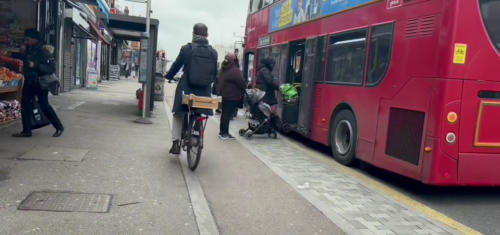
Campaigners have called for a ban on ‘floating’ bus stops, which are located on an ‘island’ between a cycle lane and the road, in London.
The design of the stops is intended to allow bus passengers to get on and off safely while cyclists can keep moving, compared to ones where the bus stop, the boarding passengers or the stopped bus encroach into the cycle lane.
Transport for London (TfL) has installed 160 of the stops so far and believes the likelihood of being injured by a cyclist at such a location is ‘very low.’
Although the Department for Transport says schemes should be accessible to all, the National Federation of the Blind UK (NFB) has produced a petition which as been signed by more than 270 organisations, including Age UK London, the London Sports Club for the Blind, and Disability Rights UK, after a video posted by the NFB showed what it said was ‘the chaotic and downright dangerous situation’ at a ‘floating’ bus stop near Waterloo.
“These designs are not safe and they need to be urgently halted,” the Federation says.
Mayor of London Sadiq Khan recently told the BBC the design of stops had been installed because a disproportionate number of cyclists had been injured and killed as a consequence of buses.
Campaigner for the NFB Sarah Gayton said: “We’re calling for a redesign of cycle lanes around bus stops so the bus can pull up directly to the pavement so blind and visually impaired people can board the bus directly without having to cross – or step into – a cycle lane,” she said. “Blind people have fewer choices. Cyclists can see and stop. We want the floating bus stops and the shared use bus boarders to be removed.”

